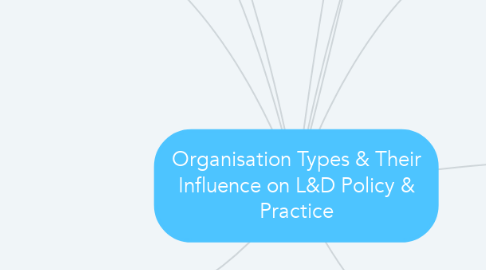Organisation Types & Their Influence on L&D Policy & Practice
by Nick Fitzsimons

1. Defining Organisations
1.1. Evolution
1.1.1. Production Focus
1.1.1.1. Age
1.1.1.1.1. Client Focus
2. Strategic Analysis - Ways to Examine a Business
2.1. SWOT
2.1.1. PESTLE
2.1.1.1. Porters 5 Forces
3. Categorising Organisations
3.1. Sector
3.1.1. Organisation/Design/Process e.g. Flat, Heirarchical
3.1.1.1. Culture e.g. Bureaucratic? Customer-centric?
3.1.1.1.1. Size
4. Organisational Structure
4.1. Mintzberg - Simple, Bureaucratic, Divisionalised, Adhocracy - Challenges for each
5. HOW DO ALL OF THESE FACTORS AFFECT L&D POLICY & PRACTICE?
6. Real Life Organisation Types & Examples
7. Creating a Philosophy of Learning
7.1. A LEARNING BELIEF SYSTEM - What is driving learning at this organisation?
7.2. Why is learning important?
7.3. What is driving learning?
7.4. Who is learning?
7.5. When and Where is learning taking place?
7.6. How is learning taking place and evaluated? - 12 points from CIPD
8. Retail
8.1. CHALLENGES INCLUDE: Shop-Floor Learners, Boosting Product & Service Knowledge, Catering to wide variety of learning styles and proving a CLEAR ROI for L&D
8.2. MEETING THOSE CHALLENGES: Balancing learner and organisation needs - Blended and bitesize learning, Designed Learning in Digital Formats, Anytime/Any Place
8.3. IMPACT ON POLICY AND PRACTICE: Anytime learning, Tablet Policy (e.g. BringYourOwnDevice
9. Finance
9.1. CHALLENGES: Constant need for innovation in line with regulation, Constant change of Technology, Reg changes
9.2. MEETING THOSE CHALLENGES: Invest in yourself first - be an SME and train up to COMMUNICATE WITH CONFIDENCE and OUTSOURCE elements of knowledge you don' tknow to trusted partners
9.3. IMPACT ON POLICY & PRACTICE: Need to Evidence learning and show controls/risk management. L&D is really a protection mechanism. All tools need to provide evidence points
10. Public Sector
10.1. CHALLENGES: Central government supplier has primacy i.e. no pick and choose. Procurement rules. Recruitment restrictions. Codes of Conduct. Differing learning styles in an international context
10.2. MEETING THOSE CHALLENGES: Being FLEXIBLE. Allowing for self-facilitation, offering things like a MOOC.
10.3. IMPACT ON POLICY AND PRACTICE: Need a central, clear L&D Strategy to build around


